Evaluation of Five Chrysanthemum morifolium Cultivars against Leaf Blight Disease Caused by Alternaria alternata at Rooting and Seedling Growth Stages
Abstract
1. Introduction
2. Materials and Methods
2.1. Plant Resources and Experimental Site
2.2. Description of the Chrysanthemum Varieties
2.3. Isolation, Purification, and Identification of the Pathogens
2.4. Screening of Chrysanthemum Cultivars against Alternaria alternata Isolates
- The disease was discovered in many cultivars in different fields, and four infected cultivars were selected.
- The infected plant samples were identified to isolate the causal agent of disease, and confirmed.
- The needed cuttings of non-infected cultivars were brought under the study to propagate in a nursery by treating their roots with a rooting hormone (indole butyric acid, IBA).
- Only one variety (Podolsk Purple) did not appear to be infected in some fields, so it was focused on to see whether it is actually a resistant variety or not.
- The selected cuttings were cultivated in trays (209 cell) for enhancing the rooting of the cuttings.
- Then, an artificial infection for the cuttings by A. alternata was performed.
- The severity of the disease infection of the different isolates on the different cultivars was determined.
- The susceptibility rate in the cultivars under study was evaluated for to the disease based on the infection degree.
- The anatomy of leaves and stems were performed to determine the resistance/sensitivity to the disease.
2.5. Disease Assessments
2.6. Vegetative and Photosynthetic Parameters
2.7. Antioxidant Capacity
2.8. Histological Examinations
2.9. Statistical Analyses
3. Results
3.1. Identification of Different Isolates of A. alternata
3.2. Vegetative Growth and Photosynthetic Parameters
3.3. Antioxidant Capacity
3.4. Histological Examinations
3.4.1. Anatomical Characters of Stems
3.4.2. Anatomical Characters of Leaves
4. Discussion
5. Conclusions
Author Contributions
Funding
Institutional Review Board Statement
Informed Consent Statement
Data Availability Statement
Acknowledgments
Conflicts of Interest
References
- Chen, J.; Dong, Y.; Wang, H.; Zhang, J.; Ma, C.; Cao, L.; Shen, L.; Cao, K.; Fan, X. Identification and complete genome sequence of a novel sadwavirus discovered in chrysanthemum (Chrysanthemum morifolium Ramat.). Arch. Virol. 2023, 168, 295. [Google Scholar] [CrossRef] [PubMed]
- Pandey, J.; Bastola, T.; Dhakal, B.; Poudel, A.; Devkota, H.P. Chrysanthemum morifolium Ramat.: A Medicinal Plant with Diverse Traditional Uses, Bioactive Constituents, and Pharmacological Activities. In Medicinal Plants of the Asteraceae Family; Devkota, H.P., Aftab, T., Eds.; Springer: Singapore, 2022; pp. 125–143. [Google Scholar] [CrossRef]
- Zhao, X.; Song, L.; Jiang, L.; Zhu, Y.; Gao, Q.; Wang, D.; Xie, J.; Lv, M.; Liu, P.; Li, M. The integration of transcriptomic and transgenic analyses reveals the involvement of the SA response pathway in the defense of chrysanthemum against the necrotrophic fungus Alternaria sp. Hort. Res. 2020, 7, 80. [Google Scholar] [CrossRef] [PubMed]
- Chen, L.; Sun, J.; Pan, Z.; Lu, Y.; Wang, Z.; Yang, L.; Sun, G. Analysis of Chemical Constituents of Chrysanthemum morifolium Extract and Its Effect on Postprandial Lipid Metabolism in Healthy Adults. Molecules 2023, 28, 579. [Google Scholar] [CrossRef] [PubMed]
- Kim, M.; Kim, Y.; Lee, H.W.; Jung, J.-C.; Oh, S. Chrysanthemum morifolium and Its Bioactive Substance Enhanced the Sleep Quality in Rodent Models via Cl− Channel Activation. Nutrients 2023, 15, 1309. [Google Scholar] [CrossRef]
- Sharma, N.; Radha; Kumar, M.; Kumari, N.; Puri, S.; Rais, N.; Natta, S.; Dhumal, S.; Navamaniraj, N.; Chandran, D.; et al. Phytochemicals, therapeutic benefits and applications of chrysanthemum flower: A review. Heliyon 2023, 9, e20232. [Google Scholar] [CrossRef] [PubMed]
- Luo, X.; Xi, Y.; Shen, C.; Wang, M.; Wang, H. Occurrence of Nigrospora sphaerica causing leaf blight on Chrysanthemum morifolium in China. Crop Prot. 2022, 157, 105982. [Google Scholar] [CrossRef]
- Sha, H.; Liu, X.; Xiao, X.; Zhang, H.; Gu, X.; Chen, W.; Mao, B. Nigrospora oryzae Causing Leaf Spot Disease on Chrysanthemum × morifolium Ramat and Screening of Its Potential Antagonistic Bacteria. Microorganisms 2023, 11, 2224. [Google Scholar] [CrossRef]
- Luo, X.; Wang, H.; Wang, M. Genomic Sequence Data of Alternaria alternata hznu325 Causing Black Leaf Spot on Chrysanthemum morifolium. Plant Dis. 2022, 106, 2506–2510. [Google Scholar] [CrossRef]
- Bradshaw, M.; Braun, U.; Götz, M.; Meeboon, J.; Takamatsu, S. Powdery mildew of Chrysanthemum × morifolium: Phylogeny and taxonomy in the context of Golovinomyces species on Asteraceae hosts. Mycologia 2017, 9, 508–519. [Google Scholar] [CrossRef]
- Magar, S.J.; Banne, S.N.; Mulekar, V.G.; Somwanshi, S.D.; Kadam, S.S. Screening of chrysanthemum varieties/hybrids against Alternaria alternata, causing leaf blight of Chrysanthemum. Pharm. Innov. 2022, 11, 2298–2300. [Google Scholar]
- Zhang, S.; Miao, W.; Liu, Y.; Jiang, J.; Chen, S.; Chen, F.; Guan, Z. Jasmonate signaling drives defense responses against Alternaria alternata in chrysanthemum. BMC Genom. 2023, 24, 553. [Google Scholar] [CrossRef] [PubMed]
- Guan, Y.; He, X.; Wen, D.; Chen, S.; Chen, F.; Chen, F.; Jiang, Y. Fusarium oxysporum infection on root elicit aboveground terpene production and salicylic acid accumulation in Chrysanthemum morifolium. Plant Physiol. Biochem. 2022, 190, 11–23. [Google Scholar] [CrossRef]
- O’Keefe, G.; Davis, D.D. Morphology of Puccinia horiana, Causal Agent of Chrysanthemum White Rust, Sampled from Naturally Infected Plants. Plant Dis. 2015, 99, 1738–1743. [Google Scholar] [CrossRef] [PubMed][Green Version]
- Castello, I.; D’Emilio, A.; Baglieri, A.; Polizzi, G.; Vitale, A. Management of Chrysanthemum Verticillium Wilt through VIF Soil Mulching Combined with Fumigation at Label and Reduced Rates. Agriculture 2022, 12, 141. [Google Scholar] [CrossRef]
- Sumitomo, K.; Shirasawa, K.; Isobe, S.N.; Hirakawa, H.; Harata, A.; Kawabe, M.; Yagi, M.; Osaka, M.; Kunihisa, M.; Taniguchi, F. DNA marker for resistance to Puccinia horiana in chrysanthemum (Chrysanthemum morifolium Ramat.) “Southern Pegasus”. Breed. Sci. 2021, 71, 261–267. [Google Scholar] [CrossRef]
- Bi, M.; Li, X.; Yan, X.; Liu, D.; Gao, G.; Zhu, P.; Mao, H. Chrysanthemum WRKY15-1 promotes resistance to Puccinia horiana Henn. via the salicylic acid signaling pathway. Hortic. Res. 2021, 8, 6. [Google Scholar] [CrossRef] [PubMed]
- Gao, G.; Jin, R.; Liu, D.; Zhang, X.; Sun, X.; Zhu, P.; Mao, H. CmWRKY15-1 Promotes Resistance to Chrysanthemum White Rust by Regulating CmNPR1 Expression. Front. Plant Sci. 2022, 13, 865607. [Google Scholar] [CrossRef]
- Munilakshmi, R.; Reddy, B.A.; Hubballi, M.; Kumar, R.; Mahesha, B.; Ugalat, J. Characterization of Puccinia horiana causing Chrysanthemum rust disease and its management by altering planting date and foliar application of fungicide. Indian. Phytopathol. 2023, 76, 437–445. [Google Scholar] [CrossRef]
- Chen, Q.; Kuang, A.; Wu, H.; Liu, D.; Zhang, X.; Mao, H. Physiological response of CmWRKY15-1 to chrysanthemum white rust based on TRV-VIGS. Front. Plant Sci. 2023, 14, 1140596. [Google Scholar] [CrossRef]
- Liu, L.; Chen, F.; Chen, S.; Fang, W.; Liu, Y.; Guan, Z. Dual species dynamic transcripts reveal the interaction mechanisms between Chrysanthemum morifolium and Alternaria alternata. BMC Genom. 2021, 22, 523. [Google Scholar] [CrossRef]
- DeMers, M. Alternaria alternata as endophyte and pathogen. Microbiology 2022, 168, 001153. [Google Scholar] [CrossRef] [PubMed]
- Hafez, Y.M.; Attia, K.A.; Alamery, S.; Ghazy, A.; Al-Dosse, A.; Ibrahim, E.; Rashwan, E.; El-Maghraby, L.; Awad, A.; Abdelaal, K.A.A. Beneficial Effects of Biochar and Chitosan on Antioxidative Capacity, Osmolytes Accumulation, and Anatomical Characters of Water-Stressed Barley Plants. Agronomy 2020, 10, 630. [Google Scholar] [CrossRef]
- Abdelaal, K.A.A.; AlKahtani, M.D.F.; Attia, K.; Hafez, Y.; Király, L.; Künstler, A. The Role of Plant Growth-Promoting Bacteria in Alleviating the Adverse Effects of Drought on Plants. Biology 2021, 10, 520. [Google Scholar] [CrossRef] [PubMed]
- El Nahhas, N.; AlKahtani, M.; Abdelaal, K.A.A.; Al Husnain, L.; AlGwaiz, H.; Hafez, Y.M.; Attia, K.; El-Esawi, M.; Ibrahim, M.; Elkelish, A. Biochar and jasmonic acid application attenuates antioxidative systems and improves growth, physiology, nutrient uptake and productivity of faba bean (Vicia faba L.) irrigated with saline water. Plant Physiol. Biochem. 2021, 166, 807–817166. [Google Scholar] [CrossRef] [PubMed]
- El-Shawa, G.M.R.; Rashwan, E.M.; Abdelaal, K.A.A. Mitigating salt stress effects by exogenous application of proline and yeast extract on morphophysiological, biochemical and anatomical characters of calendula plants. Sci. J. Flowers Ornam. Plants 2020, 7, 461–482. [Google Scholar] [CrossRef]
- Esmail, S.M.; Omara, R.I.; Abdelaal, K.A.; Hafez, Y.M. Histological and biochemical aspects of compatible and incompatible wheat-Puccinia striiformis interactions. Physiol. Mol. Plant Pathol. 2019, 106, 120–128. [Google Scholar] [CrossRef]
- Omara, R.I.; El-Kot, G.; Fadel, F.M.; Abdelaal, K.A.A.; Saleh, E.M. Efficacy of certain bioagents on patho-physiological characters of wheat plants under wheat leaf rust stress. Physiol. Mol. Plant Pathol. 2019, 106, 102–108. [Google Scholar] [CrossRef]
- Omara, R.I.; Alkhateeb, O.A.; Abdou, A.H.; El-Kot, G.A.; Shahin, A.A.; Saad-El-Din, H.I.; Abdelghany, R.; AL-Shammari, W.B.; Albadrani, M.; Hafez, Y.; et al. How to Differentiate between Resistant and Susceptible Wheat Cultivars for Leaf Rust Fungi Using Antioxidant Enzymes and Histological and Molecular Studies? Cells 2023, 12, 2643. [Google Scholar] [CrossRef]
- Pennycook, S.R. Plant Diseases Recorded in New Zealand; Plant Dis Division D.S.I.R.: Auckland, New Zealand, 1989; Volume 3.
- Shamala, G.; Janardhana, G.R. Prevalence and severity of leaf blight disease of chrysanthemum in southern regions of Karnataka and in-vitro fungicidal effect on Alternaria alternata. Int. J. Life Sci. 2015, 9, 38–45. [Google Scholar] [CrossRef]
- Domínguez-Serrano, D.; Yáñez-Morales, M.J.; García-Velasco, R.; Alanis-Martínez, I.; Segura-León, O. First report of Chrysanthemum morifolium leaf spot caused by Alternaria species in Mexico. Plant Dis. 2016, 100, 647. [Google Scholar] [CrossRef]
- Crous, P.N.; Phillips, A.J.L.; Baxter, A.P. Phytopathogenic Fungi from South Africa; University of Stellenbosch, Department of Plant Pathology Press: Stellenbosch, South Africa, 2000; p. 358. [Google Scholar]
- Alfieri, S.A.; Langdon, K.R.; Kimbrough, J.W.; El-Gholl, N.E.; Welhburg, C. Diseases and Disorders of Plants in Florida; Division of plant industry bulletin # 14; Florida Department of Agriculture and Consumer Services: Gainesville, FL, USA, 1994.
- Adolf, K.M.; Ali, M.K. Phytopathological studies on Alternaria blight of Chrysanthemum (Chrysanthemum indicum L.). Int. J. Agric. Technol. 2023, 19, 877–898. [Google Scholar]
- Kumar, K.T.; Lal, A.A.; Meghana, V.C. Study on Alternaria alternata Causing Leaf Blight Disease in Chrysanthemum (Chrysanthemum indicum L.) in Prayagraj City. Int. J. Curr. Microbiol. App Sci. 2021, 10, 1928–1934. [Google Scholar]
- Özҫelik, N.; Özҫelik, S. Investigations on Some Factors and Strains Affected the Production of Alternaria-Toxins by Thin Layer Chromatographic Method. Turk. J. Agric. For. 1997, 21, 1. Available online: https://journals.tubitak.gov.tr/agriculture/vol21/iss1/1 (accessed on 22 December 2023). [CrossRef]
- Arunkumar, G.S.; Kamanna, B.C.; Benagi, V.I. Management of chrysanthemum leaf blight caused by Alternaria alternata (fr.) Keissler under field condition. Plant Arch. 2011, 11, 553–555. [Google Scholar]
- Sultana, S.; Adhikary, S.K.; Islam, M.M.; Rahman, S.M.M. Evaluation of Pathogenic Variability Based on Leaf Blotch Disease Development Components of Bipolaris sorokiniana in Triticum aestivum and Agroclimatic Origin. Plant Pathol. J. 2018, 34, 93–103. [Google Scholar] [CrossRef]
- Yadava, U.L. A rapid and nondestructive method to determine chlorophyll in intact leaves. HortScience 1986, 21, 1449–1450. [Google Scholar] [CrossRef]
- Dewir, Y.H.; Chakrabarty, D.; Ali, M.B.; Hahn, E.J.; Paek, K.Y. Effects of hydroponic solution EC, substrates, PPF and nutrient scheduling on growth and photosynthetic competence during acclimatization of micropropagated Spathiphyllum plantlets. Plant Growth Regul. 2005, 46, 41–251. [Google Scholar] [CrossRef]
- Binsan, W.; Benjakul, S.; Visessanguan, W.; Roytrakul, S.; Tanaka, M.; Kishimura, K. Antioxidative activity of Mungoong, an extract paste, from the cephalothorax of white shrimp (Litopenaeus vannamei). Food Chem. 2008, 106, 185–193. [Google Scholar] [CrossRef]
- Ruzin, S.E. Plant Micro Technique and Microscopy; Oxford University Press, Inc.: New York, NY, USA, 1999. [Google Scholar]
- Snedecor, G.W.; Cochran, W.G. Statistical Methods, 8th ed.; Iowa State University Press: Ames, IA, USA, 1989. [Google Scholar]
- Xu, Y.; Liao, B.; Ostevik, K.L.; Zhou, H.; Wang, F.; Wang, B.; Xia, H. The Maternal Donor of Chrysanthemum Cultivars Revealed by Comparative Analysis of the Chloroplast Genome. Front. Plant Sci. 2022, 13, 923442. [Google Scholar] [CrossRef]
- Abdelaal, K.A.A. Effect of Salicylic acid and Abscisic acid on morpho-physiological and anatomical characters of faba bean plants (Vicia faba L.) under drought stress. J. Plant Prod. 2015, 6, 1771–1788. [Google Scholar] [CrossRef]
- Yeats, T.H.; Rose, J.K.C. The formation and function of plant cuticles. Plant Physiol. 2013, 163, 520. [Google Scholar] [CrossRef] [PubMed]
- Barros, J.; Serk, H.; Granlund, I.; Pesquet, E. The cell biology of lignifications in higher plants. Ann. Bot. 2015, 115, 1053–1074. [Google Scholar] [CrossRef] [PubMed]
- Shekhawat, M.S.; Mehta, S.R.; Manokari, M.; Priyadharshini, S.; Badhepuri, M.K.; Jogam, P.; Dey, A.; Rajput, B.S. Morpho-anatomical and physiological changes of Indian sandalwood (Santalum album L.) plantlets in ex vitro conditions to support successful acclimatization for plant mass production. Plant Cell Tissue Organ. Cult. 2021, 147, 423–435. [Google Scholar] [CrossRef]
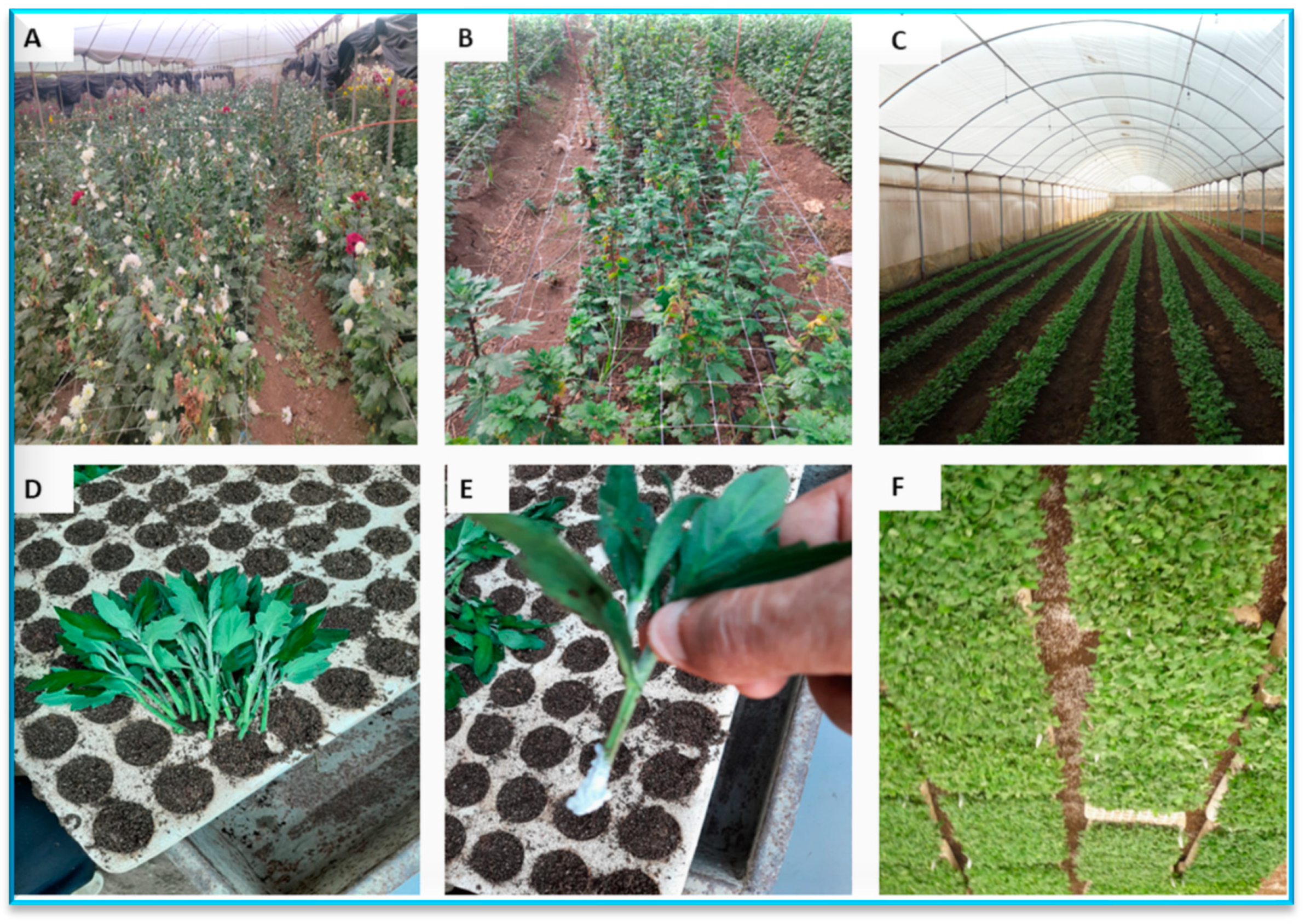


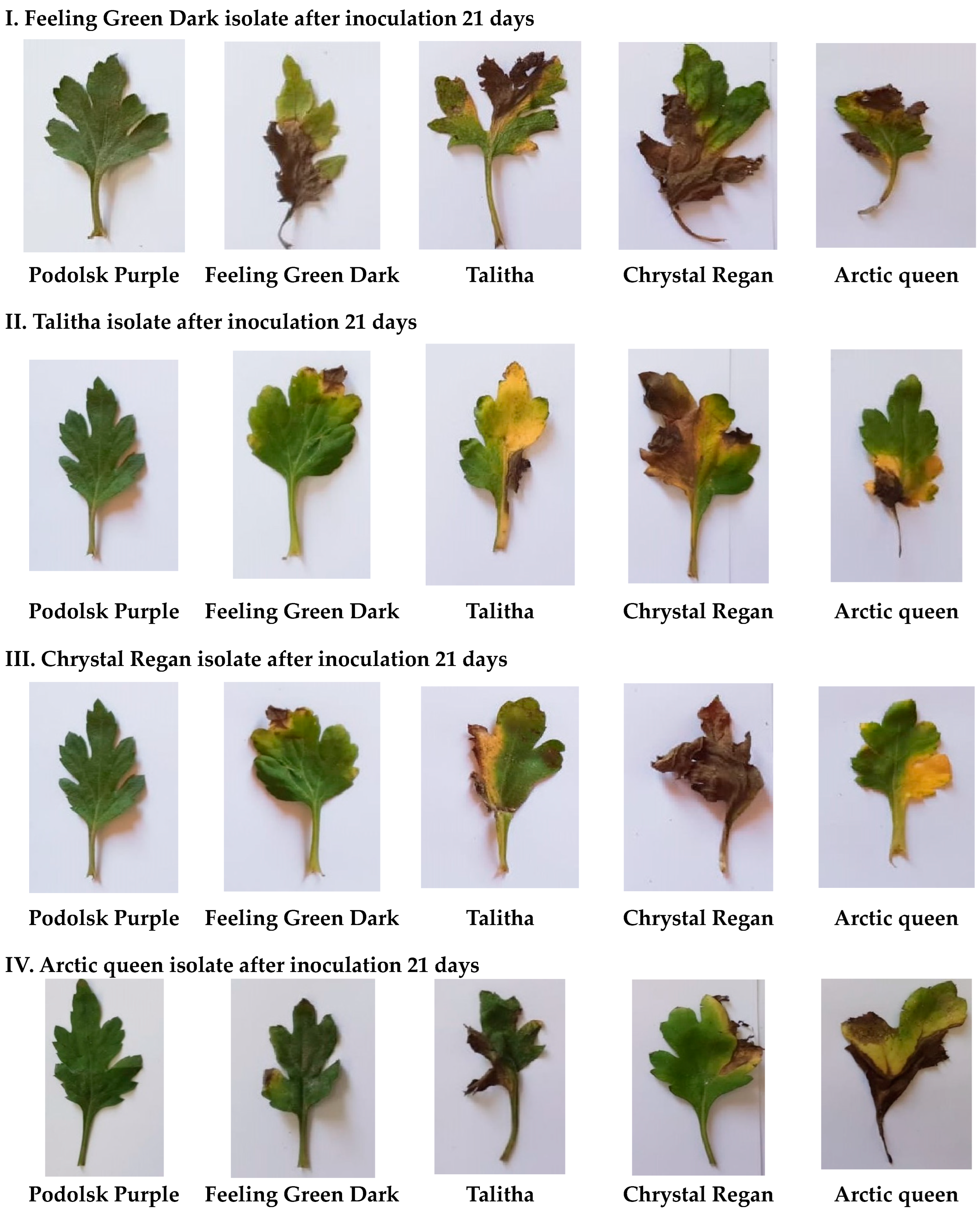

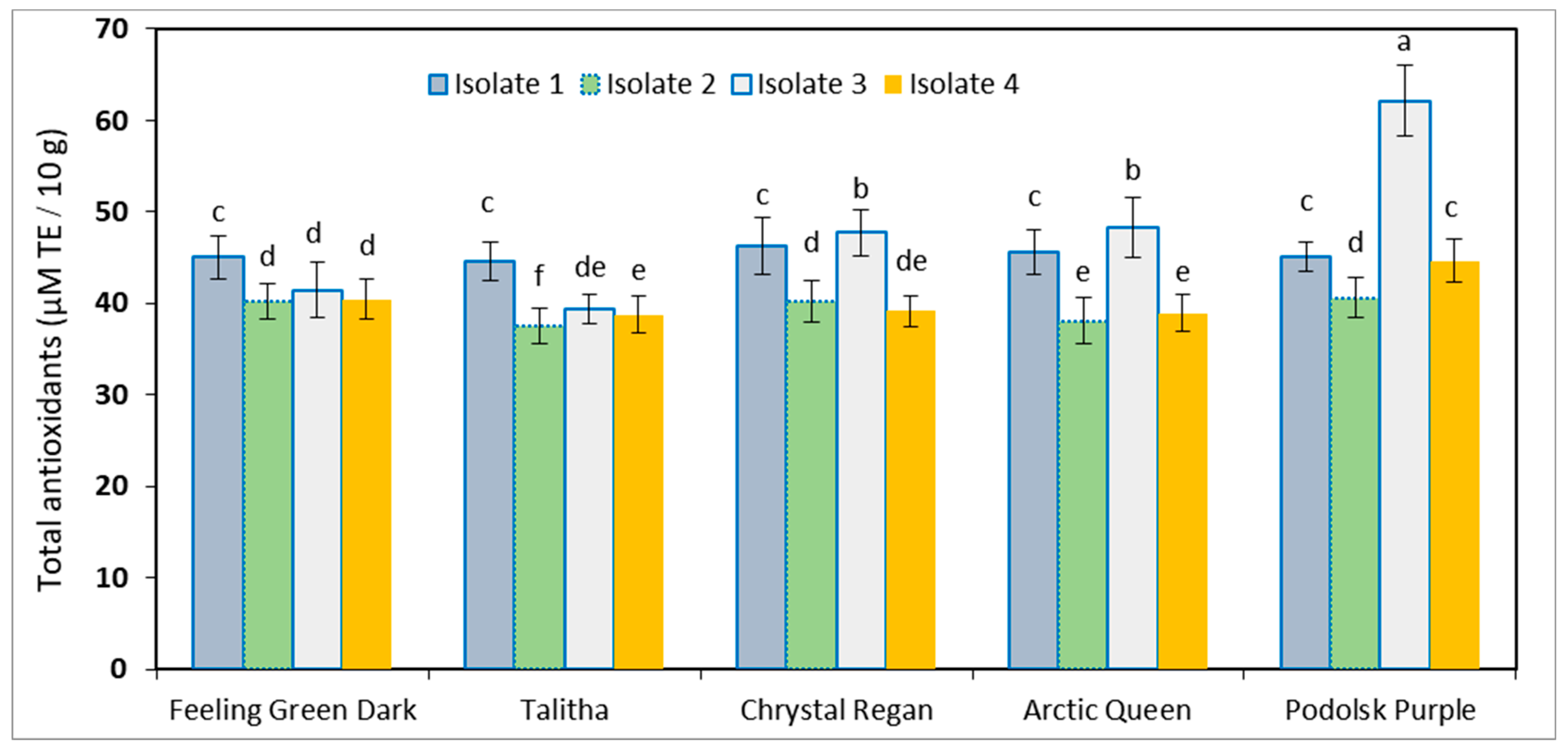
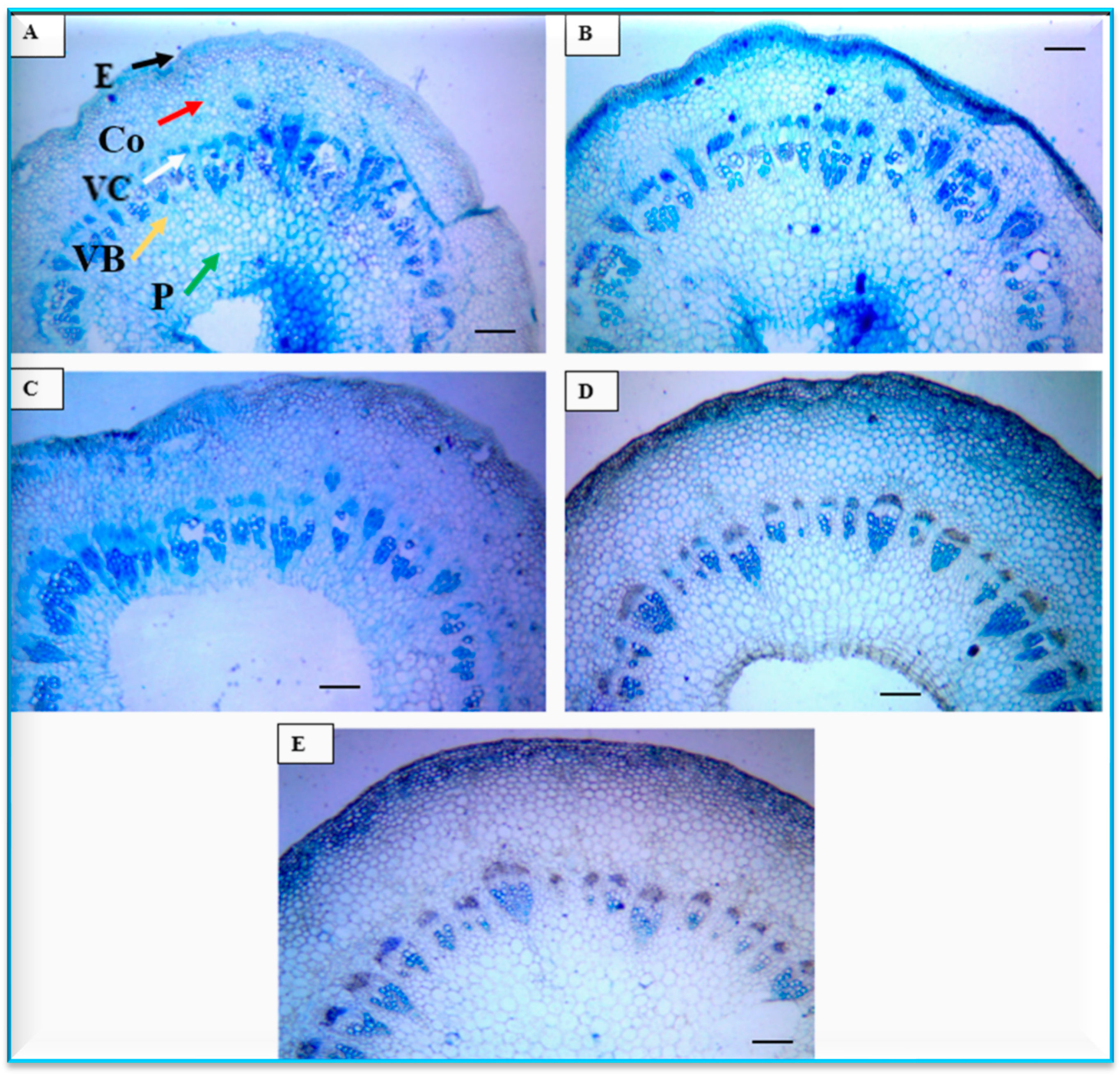
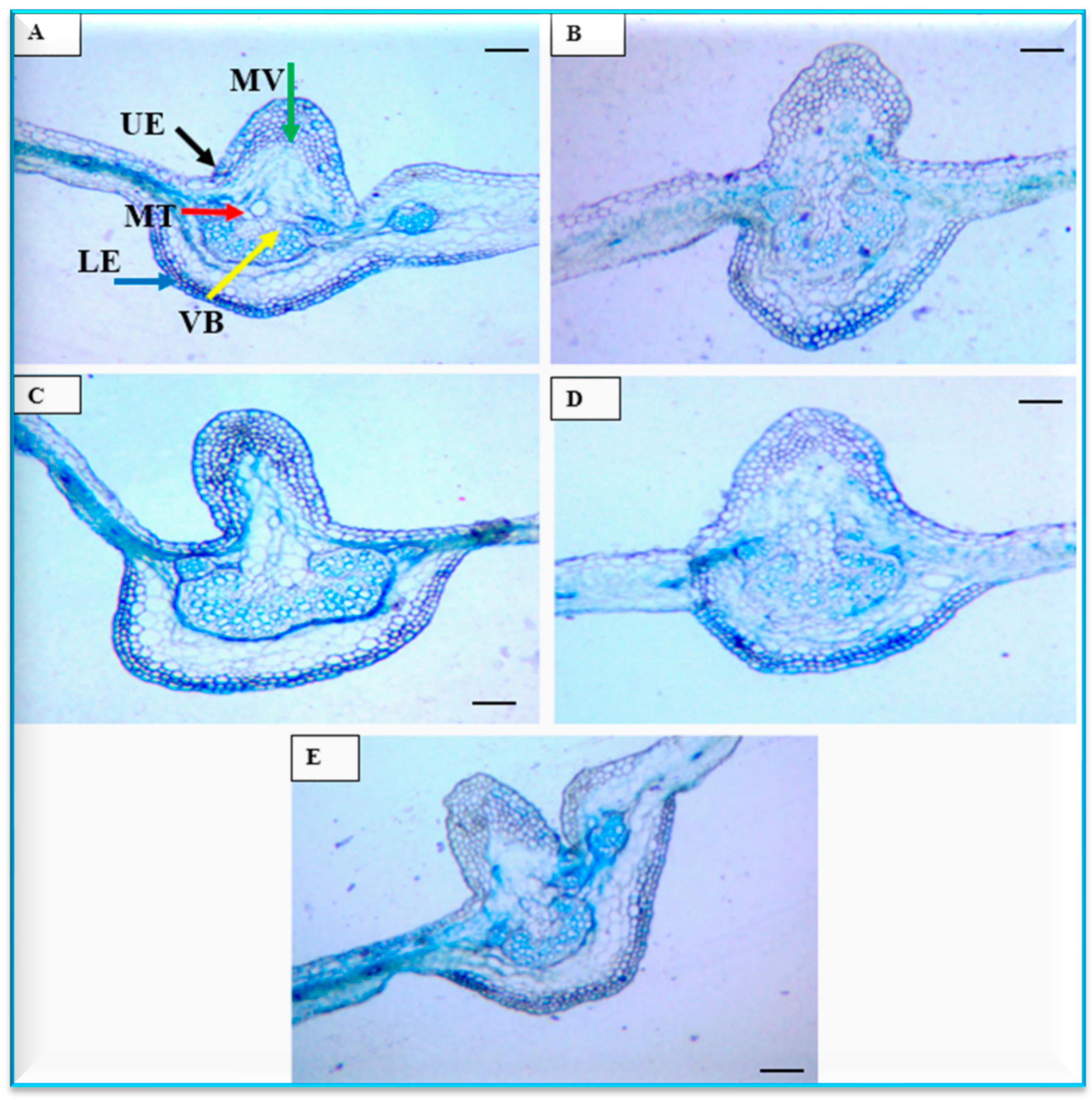
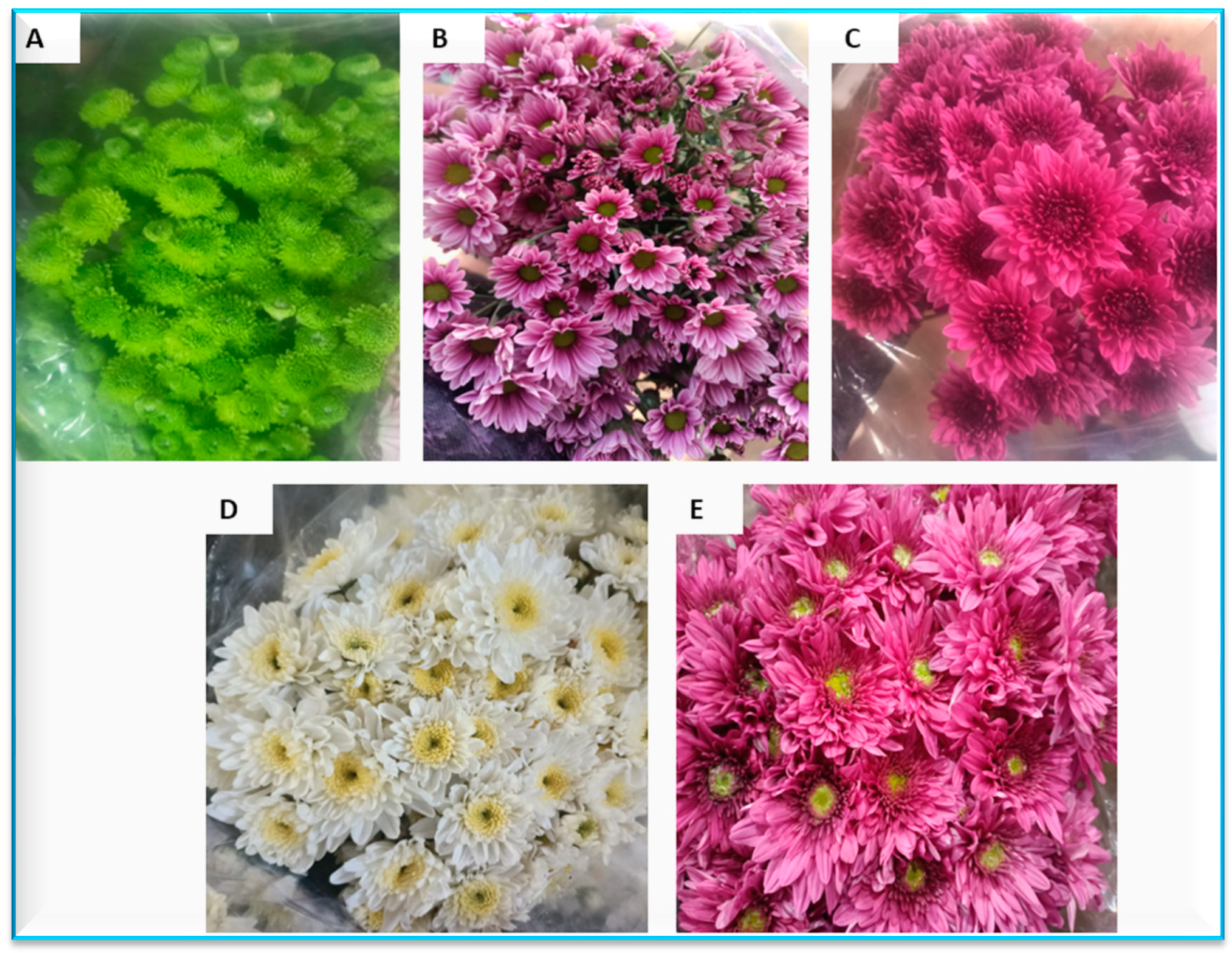
| Chrysanthemum Cultivars | Percent Disease Index (PDI %) Days After Inoculation | |||
|---|---|---|---|---|
| 7 | 14 | 21 | Mean | |
| Inoculation with A. alternata isolate from cv Feeling Green Dark | ||||
| 50.4 a ± 4.18 | 60.8 a ± 4.75 | 70.8 a ± 5.06 | 60.7 a ± 4.68 |
| 00.0 d ± 0.00 | 20.4 c ± 1.93 | 40.5 c ± 3.12 | 20.3 d ± 2.04 |
| 40.5 b ± 2.89 | 60.7 a ± 4.09 | 60.9 b ± 4.53 | 54.0 b ± 3.05 |
| 30.2 c ± 2.74 | 40.6 b ± 3.06 | 40.3 c ± 2.94 | 37.3 c ± 3.00 |
| 00.0 d ± 0.00 | 00.0 d ± 0.00 | 00.0 d ± 0.00 | 00.0 e ± 0.00 |
| F-test | ** | ** | ** | ** |
| Inoculation with A. alternata isolate from cv Talitha | ||||
| 00.0 c ± 0.00 | 00.0 d ± 0.00 | 6.1 d ± 0.48 | 2.0 c ± 0.29 |
| 20.3 b ± 1.76 | 48.6 a ± 4.33 | 84.7 a ± 6.03 | 51.2 a ± 4.84 |
| 30.8 a ± 3.36 | 40.1 b ± 3.88 | 70.5 b ± 4.88 | 47.1 a ± 4.41 |
| 30.2 a ± 3.44 | 30.5 c ± 3.52 | 40.3 c ± 4.20 | 33.7 b ± 4.03 |
| 00.0 c ± 0.00 | 00.0 d ± 0.00 | 00.0 e ± 0.00 | 00.0 c ± 0.00 |
| F-test | ** | ** | ** | ** |
| Inoculation with A. alternata isolate from cv Chrystal Regan | ||||
| 10.1 c ± 0.85 | 12.3 c ± 1.10 | 12.5 c ± 1.11 | 11.6 c ± 1.06 |
| 8.5 c ± 0.69 | 10.2 c ± 0.88 | 14.7 c ± 1.13 | 11.1 c ± 1.12 |
| 72.8 a ± 5.12 | 80.4 a ± 5.77 | 92.2 a ± 5.82 | 81.8 a ± 5.52 |
| 20.4 b ± 2.19 | 30.7 b ± 3.52 | 30.4 b ± 3.29 | 27.2 b ± 2.99 |
| 00.0 d ± 0.00 | 00.0 d ± 0.00 | 00.0 d ± 0.00 | 00.0 d ± 0.00 |
| F-test | ** | ** | ** | ** |
| Inoculation with A. alternata isolate from cv Arctic queen | ||||
| 10.3 c ± 0.79 | 12.4 d ± 1.01 | 15.2 d ± 1.11 | 12.6 d ± 1.21 |
| 12.2 c ± 0.94 | 20.3 c ± 2.17 | 26.4 c ± 2.29 | 20.0 c ± 2.22 |
| 20.7 b ± 2.88 | 32.9 b ± 3.27 | 40.5 b ± 4.03 | 31.0 b ± 2.98 |
| 68.3 a ± 5.01 | 72.1 a ± 4.99 | 80.5 a ± 5.29 | 73.6 a ± 5.13 |
| 00.0 d ± 0.00 | 00.0 e ± 0.00 | 00.0 e ± 0.00 | 00.0 e ± 0.00 |
| F-test | ** | ** | ** | ** |
| Treatments | Number of Roots per Seedling | Number of Leaves per Seedling | Root Length (cm) | Root F.W. (g/seedling) | Seedling F.W. (g/seedling) | |
|---|---|---|---|---|---|---|
| Isolates | Cultivars | |||||
| Isolate 1 | Feeling Green Dark | 26.04 bc ± 3.05 | 9.35 c ± 1.52 | 3.93 ab ± 0.85 | 0.31 b ± 0.05 | 2.12 b ± 0.48 |
| Talitha | 25.27 c ± 1.00 | 8.71 d ± 0.58 | 3.56 b ± 0.47 | 0.30 b ± 0.03 | 2.10 b ± 0.24 | |
| Chrystal Regan | 23.50 d ± 3.79 | 7.73 e ± 1.53 | 2,60 d ± 0.05 | 0.27 bc ± 0.07 | 1.92 c ± 0.33 | |
| Arctic Queen | 24.50 d ± 1.25 | 8.77 d ± 0.58 | 3.16 c ± 0.76 | 0.29 b ± 0.09 | 2.14 b ± 0.24 | |
| Podolsk Purple | 30.10 ab ± 3.77 | 10.35 b ± 1.88 | 3.99 ab ± 0.45 | 0.35 a ± 0.07 | 2.42 ab ± 0.17 | |
| Isolate 2 | Feeling Green Dark | 28.11 b ± 6.24 | 10.12 b ± 0.58 | 3.79 b ± 1.00 | 0.23 cd ± 0.01 | 1.96 c ± 0.41 |
| Talitha | 27.34 b ± 6.12 | 9.47 c ± 0.58 | 3.73 b ± 0.49 | 0.23 cd ± 0.04 | 1.94 c ± 0.11 | |
| Chrystal Regan | 25.57 c ± 6.24 | 8.49 d ± 1.52 | 2.77 c ± 0.50 | 0.20 d ± 0.08 | 1.76 d ± 0.40 | |
| Arctic Queen | 26.57 bc ± 5.03 | 9.54 c ± 3.21 | 3.33 b ± 0.50 | 0.22 cd ± 0.07 | 1.98 c ± 0.49 | |
| Podolsk Purple | 32.17 a ± 2.08 | 11.12 a ± 1.15 | 4.16 ab ± 0.06 | 0.27 bc ± 0.03 | 2.26 b ± 0.30 | |
| Isolate 3 | Feeling Green Dark | 21.95 e ± 3.77 | 9.22 c ± 1.73 | 3.93 ab ± 0.50 | 0.21 cd ± 0.01 | 1.69 de ± 0.19 |
| Talitha | 21.17 e ± 4.51 | 8.57 d ± 0.58 | 3.81 b ± 0.50 | 0.21 cd ± 0.20 | 1.67 de ± 0.19 | |
| Chrystal Regan | 19.40 g ± 3.61 | 7.59 e ± 1.52 | 2.85 c ± 0.58 | 0.18 e ± 0.02 | 1.49 e ± 0.15 | |
| Arctic Queen | 20.40 f ± 1.53 | 8.62 d ± 0.58 | 3.40 b ± 0.92 | 0.20 d ± 0.05 | 1.71 d ± 0.39 | |
| Podolsk Purple | 26.00 bc ± 4.93 | 10.22 b ± 0.58 | 4.23 a ± 0.36 | 0.25 c ± 0.02 | 1.99 c ± 0.26 | |
| Isolate 4 | Feeling Green Dark | 22.75 de ± 1.54 | 9.35 c ± 0.58 | 4.06 ab ± 1.04 | 0.31 b ± 0.05 | 2.35 ab ± 0.27 |
| Talitha | 21.97 e ± 4.93 | 8.71 d ± 1.52 | 3.93 ab ± 1.00 | 0.30 b ± 0.07 | 2.33 ab ± 0.21 | |
| Chrystal Regan | 20.20 f ± 3.51 | 7.73 e ± 2.00 | 2.97 c ± 1.00 | 0.27 bc ± 0.07 | 2.15 b ± 0.21 | |
| Arctic Queen | 21.20 e ± 1.53 | 8.77 d ± 1.00 | 3.53 b ± 0.32 | 0.29 b ± 0.08 | 2.36 ab ± 0.33 | |
| Podolsk Purple | 26.80 bc ± 5.27 | 10.35 b ± 1.73 | 4.36 a ± 0.92 | 0.35 a ± 0.04 | 2.65 a ± 0.43 | |
| Significance | ||||||
| I (Isolates) | ** | * | * | ** | ** | |
| C (Cultivar) | ** | ** | ** | ** | ** | |
| I × C | ** | * | * | * | ** | |
| Treatments | Root Dry Weight (g/seedling) | Seedling Dry Weight (g/seedling) | Total Chlorophyll Content (SPAD) | Fv/Fm | |
|---|---|---|---|---|---|
| Isolates | Cultivars | ||||
| Isolate 1 | Feeling Green Dark | 0.10 a ± 0.01 | 0.42 b ± 0.04 | 18.70 e ± 1.24 | 0.79 a ± 0.06 |
| Talitha | 0.09 a ± 0.01 | 0.41 b ± 0.04 | 18.62 e ± 2.17 | 0.79 a ± 0.06 | |
| Chrystal Regan | 0.08 a ± 0.01 | 0.38 c ± 0.05 | 17.58 f ± 1.91 | 0.79 a ± 0.00 | |
| Arctic Queen | 0.09 a ± 0.01 | 0.42 b ± 0.05 | 18.67 e ± 1.70 | 0.80 a ± 0.05 | |
| Podolsk Purple | 0.11 a ± 0.02 | 0.45 ab ± 0.04 | 20.09 c ± 1.90 | 0.80 a ± 0.07 | |
| Isolate 2 | Feeling Green Dark | 0.08 a ± 0.01 | 0.38 c ± 0.03 | 20.84 bc ± 2.07 | 0.79 a ± 0.06 |
| Talitha | 0.07 a ± 0.01 | 0.37 c ± 0.03 | 20.77 bc ± 1.80 | 0.78 a ± 0.02 | |
| Chrystal Regan | 0.06 a ± 0.01 | 0.34 de ± 0.03 | 19.72 d ± 2.06 | 0.78 a ± 0.02 | |
| Arctic Queen | 0.07 a ± 0.01 | 0.38 c ± 0.04 | 20.81 bc ± 1.91 | 0.79 a ± 0.02 | |
| Podolsk Purple | 0.09 a ± 0.01 | 0.41 b ± 0.05 | 22.24 a ± 3.08 | 0.80 a ± 0.02 | |
| Isolate 3 | Feeling Green Dark | 0.07 a ± 0.01 | 0.33 de ± 0.02 | 19.39 d ± 5.05 | 0.79 a ± 0.02 |
| Talitha | 0.06 a ± 0.01 | 0.32 e ± 0.03 | 19.31 d ± 3.16 | 0.78 a ± 0.01 | |
| Chrystal Regan | 0.05 a ± 0.01 | 0.28 f ± 0.03 | 18.27 ef ± 0.71 | 0.78 a ± 0.01 | |
| Arctic Queen | 0.06 a ± 0.01 | 0.32 de ± 0.05 | 19.36 d ± 1.17 | 0.79 a ± 0.02 | |
| Podolsk Purple | 0.08 a ± 0.01 | 0.35 d ± 0.06 | 20.78 bc ± 3.04 | 0.80 a ± 0.02 | |
| Isolate 4 | Feeling Green Dark | 0.09 a ± 0.02 | 0.44 ab ± 0.06 | 21.60 b ± 4.01 | 0.79 a ± 0.01 |
| Talitha | 0.08 a ± 0.01 | 0.43 ab ± 0.05 | 21.52 b ± 3.36 | 0.78 a ± 0.01 | |
| Chrystal Regan | 0.08 a ± 0.01 | 0.39 bc ± 0.07 | 20.48 c ± 4.01 | 0.78 a ± 0.01 | |
| Arctic Queen | 0.08 a ± 0.01 | 0.43 ab ± 0.04 | 21.57 b ± 3.38 | 0.79 a ± 0.02 | |
| Podolsk Purple | 0.10 a ± 0.01 | 0.46 a ± 0.06 | 22.99 a ± 4.11 | 0.80 a ± 0.02 | |
| Significance | |||||
| I (Isolates) | ** | ** | ** | * | |
| C (Cultivar) | * | * | * | ** | |
| I × C | NS | ** | * | NS | |
| Cultivars | Thickness of Cuticle (µm) | Thickness of Epidermis (µm) | Cortex Thickness (µm) | Vascular Cylinder Diameter (µm) | Stem Diameter (µm) | Diameter of Xylem Vessel (µm) |
|---|---|---|---|---|---|---|
| Feeling Green Dark | 1.67 b ± 0.15 | 4.90 a ± 0.67 | 52.96 c ± 5.55 | 248.60 c ± 9.00 | 365.98 d ± 4.80 | 13.42 b ± 0.82 |
| Talitha | 2.51 b ± 0.35 | 4.57 a ± 0.79 | 52.52 c ± 2.08 | 287.24 a ± 0.96 | 403.85 c ± 3.89 | 14.16 b ± 0.87 |
| Chrystal Regan | 2.58 b ± 0.38 | 4.21 a ± 0.53 | 75.90 b ± 1.95 | 278.21 a ± 0.98 | 428.04 b ± 6.51 | 13.26 b ± 0.61 |
| Arctic Queen | 2.55 b ± 0.81 | 4.04 a ± 1.25 | 70.39 b ± 2.45 | 263.26 b ± 2.62 | 408.58 c ± 4.86 | 12.95 c ± 1.83 |
| Podolsk Purple | 3.94 a ± 0.69 | 3.97 a ± 0.91 | 99.03 a ± 4.48 | 279.06 a ± 8.05 | 490.760 a ± 2.06 | 17.09 a ± 0.79 |
| F. test | ** | NS | ** | ** | ** | ** |
| Cultivars | Thickness of Cuticle (µm) | Thickness of Epidermis (µm) | Thickness of Mesophyll Tissue (µm) | Thickness of Lamina (µm) | Thickness of Middle Vein (µm) | Diameter of Vascular Bundle (µm) |
|---|---|---|---|---|---|---|
| Feeling Green Dark | 3.08 c ± 0.60 | 9.64 bc ± 1.26 | 51.12 a ± 2.35 | 65.23 a ± 5.97 | 150.80 d ± 0.49 | 69.15 b ± 1.91 |
| Talitha | 6.13 a ± 0.69 | 10.96 b ± 1.40 | 27.41 b ± 3.57 | 46.98 b ± 5.70 | 208.91 a ± 0.46 | 109.78 a ± 15.07 |
| Chrystal Regan | 5.42 ab ± 0.35 | 7.63 c ± 1.03 | 17.81 c ± 2.61 | 23.84 c ± 3.25 | 209.29 a ± 2.02 | 118.20 a ± 13.62 |
| Arctic Queen | 5.76 a ± 0.95 | 8.43 bc ± 2.06 | 28.93 b ± 3.98 | 39.69 b ± 4.39 | 197.44 b ± 2.93 | 109.89 a ± 1.75 |
| Podolsk Purple | 4.33 b ± 0.51 | 14.26 a ± 1.07 | 45.20 a ± 4.70 | 68.53 a ± 1.77 | 171.76 c ± 2.08 | 81.90 b ± 2.92 |
| F. test | ** | ** | ** | ** | ** | ** |
Disclaimer/Publisher’s Note: The statements, opinions and data contained in all publications are solely those of the individual author(s) and contributor(s) and not of MDPI and/or the editor(s). MDPI and/or the editor(s) disclaim responsibility for any injury to people or property resulting from any ideas, methods, instructions or products referred to in the content. |
© 2024 by the authors. Licensee MDPI, Basel, Switzerland. This article is an open access article distributed under the terms and conditions of the Creative Commons Attribution (CC BY) license (https://creativecommons.org/licenses/by/4.0/).
Share and Cite
Seliem, M.K.; Taha, N.A.; El-Feky, N.I.; Abdelaal, K.; El-Ramady, H.; El-Mahrouk, M.E.; Bayoumi, Y.A. Evaluation of Five Chrysanthemum morifolium Cultivars against Leaf Blight Disease Caused by Alternaria alternata at Rooting and Seedling Growth Stages. Plants 2024, 13, 252. https://doi.org/10.3390/plants13020252
Seliem MK, Taha NA, El-Feky NI, Abdelaal K, El-Ramady H, El-Mahrouk ME, Bayoumi YA. Evaluation of Five Chrysanthemum morifolium Cultivars against Leaf Blight Disease Caused by Alternaria alternata at Rooting and Seedling Growth Stages. Plants. 2024; 13(2):252. https://doi.org/10.3390/plants13020252
Chicago/Turabian StyleSeliem, Mayada K., Naglaa A. Taha, Nahla I. El-Feky, Khaled Abdelaal, Hassan El-Ramady, Mohammed E. El-Mahrouk, and Yousry A. Bayoumi. 2024. "Evaluation of Five Chrysanthemum morifolium Cultivars against Leaf Blight Disease Caused by Alternaria alternata at Rooting and Seedling Growth Stages" Plants 13, no. 2: 252. https://doi.org/10.3390/plants13020252
APA StyleSeliem, M. K., Taha, N. A., El-Feky, N. I., Abdelaal, K., El-Ramady, H., El-Mahrouk, M. E., & Bayoumi, Y. A. (2024). Evaluation of Five Chrysanthemum morifolium Cultivars against Leaf Blight Disease Caused by Alternaria alternata at Rooting and Seedling Growth Stages. Plants, 13(2), 252. https://doi.org/10.3390/plants13020252








